Collegiate Church of St Mary, Warwick
The Collegiate Church of St Mary is a Church of England parish church in the town of Warwick, England. It is in the centre of the town just east of the market place. It is a member of the Greater Churches Group.
| Collegiate Church of St Mary, Warwick | |
|---|---|
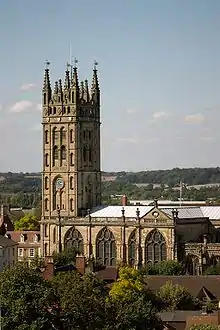 Tower and nave of the church as viewed from Warwick Castle | |
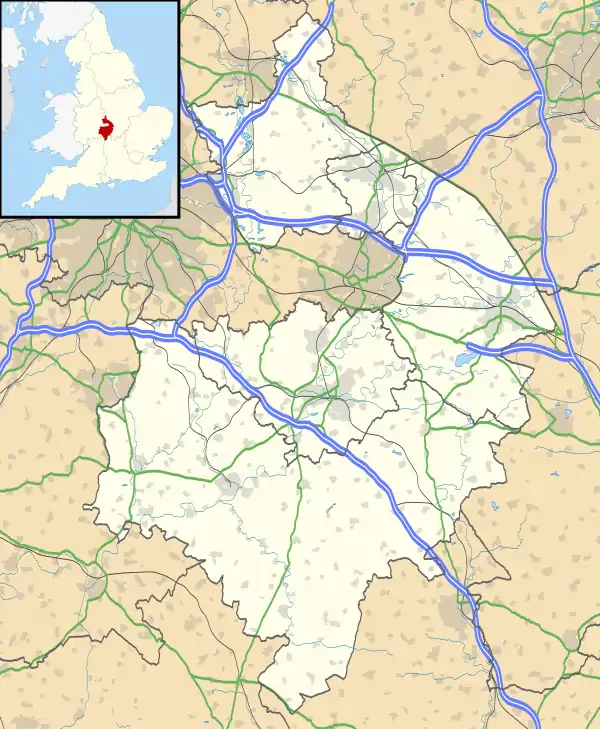 Collegiate Church of St Mary, Warwick | |
| 52°16′56″N 1°35′17″W | |
| Country | United Kingdom |
| Denomination | Church of England |
| Churchmanship | High Church |
| Website | website |
| History | |
| Dedication | Blessed Virgin Mary |
| Administration | |
| Parish | Warwick, St Mary |
| Deanery | Warwick & Leamington |
| Archdeaconry | Warwick |
| Diocese | Coventry |
| Province | Canterbury |
| Clergy | |
| Vicar(s) | Vaughan Roberts |
| Laity | |
| Organist(s) | Oliver Hancock (Director of Music) Mark Swinton (Assistant Director of Music) |
The church has the status of collegiate church as it had a college of secular canons. In governance and religious observance it was similar to a cathedral (although not the seat of a bishop and without diocesan responsibilities). There is a Bishop of Warwick, but this is an episcopal title used by a suffragan bishop of the Diocese of Coventry.
History
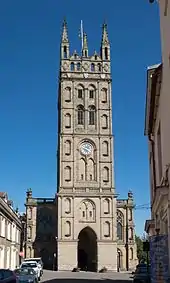
Foundation and early years
The church foundations date back nearly nine hundred years, being created by Roger de Beaumont, 2nd Earl of Warwick, in 1123.[1] In addition to founding the church, de Beaumont established the College of Dean and Canons at the church. The only surviving part of the Norman church which de Beaumont had built is the crypt.
The chancel vestries and chapter house of the church were extensively rebuilt in the 14th century by a later Earl of Warwick, Thomas de Beauchamp (later pronounced Beecham), in the Perpendicular Gothic style.[2] His descendants built the Chapel of Our Lady, commonly known as the Beauchamp Chapel. It contains the effigial monuments of Richard de Beauchamp, 13th Earl of Warwick, Ambrose Dudley, 3rd Earl of Warwick, and Robert Dudley, 1st Earl of Leicester. Buried in the chancel of the church is William Parr, 1st Marquess of Northampton, the brother of Queen consort Catherine Parr.[3]
Sixteenth century to present
The college was dissolved in 1546, and the church was granted by the crown to the burgesses of Warwick.[2] Before their destruction in the Civil War, Wencelaus Hollar copied many of the stained glass windows in the Beauchamp Chapel, showing heraldry of the Beauchamp family.
The church, along with much of Warwick, was devastated by the Great Fire of Warwick in 1693. The nave and tower of the building were completely destroyed. In 1704, the rebuilt church was completed in a Gothic design by William Wilson (appointed by the Crown Commissioners).[4] Sir Christopher Wren is also said to have contributed to the design, but that is disputed.[1][2] The tower rises to the height of 130 feet.[3] The design was described by John Summerson as being "as remarkable for its success as for its independence in style from other seventeenth-century English Gothic". [5]
Deans of the College
|
|
|
Music
Organs
There are two organs in St. Mary's, the transept organ and one at the west end. The specifications of both organs can be found on the National Pipe Organ Register.[6][7]
Organists (prior to 1976)
|
|
(The position of Organist was replaced with that of Director of Music from 1976) |
Directors of Music
|
|
|
Assistant Organists
|
|
(The position of Assistant Organist was replaced with that of Organist from 1989) |
Organists (from 1989)
- Kevin Bowyer 1989
- Christopher Monks 1998
(from 1999 the position of Organist was combined with the new post of Assistant Director of Music)
Organists and Assistant Directors of Music
- Christopher Monks 1999 (originally appointed as Organist in 1998)
- Luke Bond 2002 (Assistant Director of Music, Truro Cathedral from 2008)
- Ruaraidh Sutherland 2006 (Organist at Christ's Hospital from 2019)
- Mark Swinton 2011
Image gallery
 From Northgate Street
From Northgate Street Beauchamp Chapel
Beauchamp Chapel Beauchamp Chapel west wall
Beauchamp Chapel west wall Church Nave Alter
Church Nave Alter The Crypt
The Crypt Dean's Chapel
Dean's Chapel Interior looking east
Interior looking east Interior looking west
Interior looking west The view from within the Beauchamp Chapel
The view from within the Beauchamp Chapel The entrance to the Beauchamp family chapel in St Mary's
The entrance to the Beauchamp family chapel in St Mary's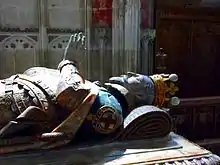 Effigy of Ambrose Dudley on his tomb in the Beauchamp Chapel
Effigy of Ambrose Dudley on his tomb in the Beauchamp Chapel Bear at feet of Ambrose Dudley on his tomb
Bear at feet of Ambrose Dudley on his tomb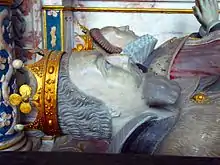 Effigies of Robert Dudley and Lettice Knollys on their tomb in the Beauchamp Chapel
Effigies of Robert Dudley and Lettice Knollys on their tomb in the Beauchamp Chapel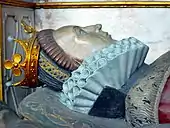 Effigy of Lettice Knollys.
Effigy of Lettice Knollys. Lion rampant queue-fourché, emblem of the Dudley family, on the Dudley/Knollys tomb
Lion rampant queue-fourché, emblem of the Dudley family, on the Dudley/Knollys tomb Inscription on rear panel of tomb of Robert Dudley and Lettice Knollys
Inscription on rear panel of tomb of Robert Dudley and Lettice Knollys Coat of Arms of Robert Dudley, Earl of Leicester
Coat of Arms of Robert Dudley, Earl of Leicester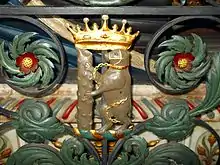 Bear and ragged staff, emblem of the earls, city and county of Warwick. Tomb of Robert Dudley and Lettice Knollys
Bear and ragged staff, emblem of the earls, city and county of Warwick. Tomb of Robert Dudley and Lettice Knollys Effigy of Richard Beauchamp
Effigy of Richard Beauchamp Effigy of Robert Dudley, son of Robert Dudley and Lettice Knollys, known as the "Noble Impe", on his tomb in the Beauchamp Chapel
Effigy of Robert Dudley, son of Robert Dudley and Lettice Knollys, known as the "Noble Impe", on his tomb in the Beauchamp Chapel Tomb of Robert Dudley, the "Noble Impe"
Tomb of Robert Dudley, the "Noble Impe" Inscription on tomb of the "Noble Impe"
Inscription on tomb of the "Noble Impe"
References
- Cooke, Henry T. (1841). A Description of the Collegiate Church and Choir of St. Mary, Warwick and the Beauchamp Chapel Adjoining Thereto.
- Smith, William (1830). A New & Compendious History, of the County of Warwick: From the Earliest Period to the Present Time, Comprising Views, of the Principal Towns, Buildings, Modern Improvements, Seats of the Nobility & Gentry, Ecclesiastical Edifices. W. Emans.
- "Warter - Warwick-Bridge", A Topographical Dictionary of England (1848), pp. 475-482. Date accessed: 28 May 2011.
- Sabin, John; Hands, John (1757). A Brief description of the Collegiate Church and Choir of St. Mary's in Warwick: With a concise account of the antiquities and curiosities of the same, and of the chapel adjoyning thereto. Henry Keating.
- Summerson, John (1970). Architecture in Britain, 1530 to 1830. Pelican History of Art. Harmondsworth: Penguin Books. p. 265.
- "Transept Organ", National Pipe Organ Register, British Institute of Organ Studies.
- "West End Organ", National Pipe Organ Register, British Institute of Organ Studies.
- The Canadian Encyclopedia
Further reading
- "Colleges: St Mary, Warwick", A History of the County of Warwick,
Volume 2 (1908), pp. 124–129.
External links
| Wikimedia Commons has media related to Collegiate Church of St Mary, Warwick. |
